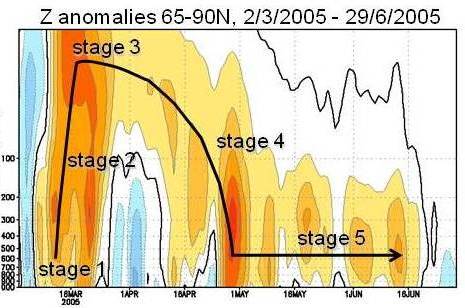|
CLIMATE RESEARCH GROUP
Stratospheric impacts on tropospheric weather and climate
Previous research indicates that the stratosphere has important impacts on tropospheric weather and climate. For example, extreme circulation anomalies in the stratosphere, which are so-called stratospheric sudden warmings
(SSWs),
tend to propagate downward from the stratosphere into the troposphere and influence the state of the Arctic Oscillation
(AO)
over the northern hemisphere. The slow time scale associated with such events suggests that their proper simulation could improve the prediction skill of short-term climate forecasts (weeks to months).
 Different phases of a stratospheric sudden warming event (vortex split), visualized by the distribution of potential vorticty (adapted from L. Polvani, U. Columbia).
Different phases of a stratospheric sudden warming event (vortex split), visualized by the distribution of potential vorticty (adapted from L. Polvani, U. Columbia).
The stratosphere may also play an important role for climate change. For example, during recent decades the stratosphere has been cooling in response to both increased amounts of greenhouse gases and stratospheric ozone depletion. These temperature perturbations induced stratospheric circulation changes, which in turn may lead to tropospheric climate change through the dynamical interaction between the stratosphere and the troposphere. For example, the recent trend of the Antarctic Oscillation
(AAO)
towards a more positive state and the associated circulation change at the surface is likely related to the Antarctic ozone hole.

Downward propagation of an extreme stratospheric sudden waring event during Spring 2005. Shown is the time height evolution of the standardized geopotential height anoamlies over the northern polar cap analyzed from NCEP/NCAR reanalysis. Vertical axis shows pressure in hPa, and horizontal axis shows time in days.
Although it is well established that stratospheric processes are important for the troposphere, there is still much to be learned about the characteristics, significance, and mechanisms of these effects. In this project we study these processes by conducting and analyzing specifically designed numerical experiments. Our goal is to better understand how important the stratosphere really is for the prediction of tropospheric weather and climate. Amongst others, these activities are connected to various international projects such as
SPARC,
DynVar, and
CCMVal.
Further reading
Reichler, T., P. J. Kushner, and L. M. Polvani (2005):
The coupled stratosphere-troposphere response to impulsive
forcing from the troposphere,
J. Atmos. Sci., 62 (9), 3337-3352.
[PDF]
This page has been visited
[an error occurred while processing this directive]
times since Friday, 07-Nov-2008 12:03:44 MST
|